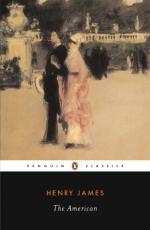was edged with shabby farm-buildings an immense facade
of dark time-stained brick, flanked by two low wings,
each of which terminated in a little Dutch-looking
pavilion capped with a fantastic roof. Two towers
rose behind, and behind the towers was a mass of elms
and beeches, now just faintly green. But the
great feature was a wide, green river which washed
the foundations of the chateau. The building rose
from an island in the circling stream, so that this
formed a perfect moat spanned by a two-arched bridge
without a parapet. The dull brick walls, which
here and there made a grand, straight sweep; the ugly
little cupolas of the wings, the deep-set windows,
the long, steep pinnacles of mossy slate, all mirrored
themselves in the tranquil river. Newman rang
at the gate, and was almost frightened at the tone
with which a big rusty bell above his head replied
to him. An old woman came out from the gate-house
and opened the creaking portal just wide enough for
him to pass, and he went in, across the dry, bare
court and the little cracked white slabs of the causeway
on the moat. At the door of the chateau he waited
for some moments, and this gave him a chance to observe
that Fleurieres was not “kept up,” and
to reflect that it was a melancholy place of residence.
“It looks,” said Newman to himself—and
I give the comparison for what it is worth—“like
a Chinese penitentiary.” At last the door
was opened by a servant whom he remembered to have
seen in the Rue de l’Universite. The man’s
dull face brightened as he perceived our hero, for
Newman, for indefinable reasons, enjoyed the confidence
of the liveried gentry. The footman led the way
across a great central vestibule, with a pyramid of
plants in tubs in the middle of glass doors all around,
to what appeared to be the principal drawing-room
of the chateau. Newman crossed the threshold
of a room of superb proportions, which made him feel
at first like a tourist with a guide-book and a cicerone
awaiting a fee. But when his guide had left him
alone, with the observation that he would call Madame
la Comtesse, Newman perceived that the salon contained
little that was remarkable save a dark ceiling with
curiously carved rafters, some curtains of elaborate,
antiquated tapestry, and a dark oaken floor, polished
like a mirror. He waited some minutes, walking
up and down; but at length, as he turned at the end
of the room, he saw that Madame de Cintre had come
in by a distant door. She wore a black dress,
and she stood looking at him. As the length of
the immense room lay between them he had time to look
at her before they met in the middle of it.
He was dismayed at the change in her appearance. Pale, heavy-browed, almost haggard with a sort of monastic rigidity in her dress, she had little but her pure features in common with the woman whose radiant good grace he had hitherto admired. She let her eyes rest on his own, and she let him take her hand; but her eyes looked like two rainy autumn moons, and her touch was portentously lifeless.




